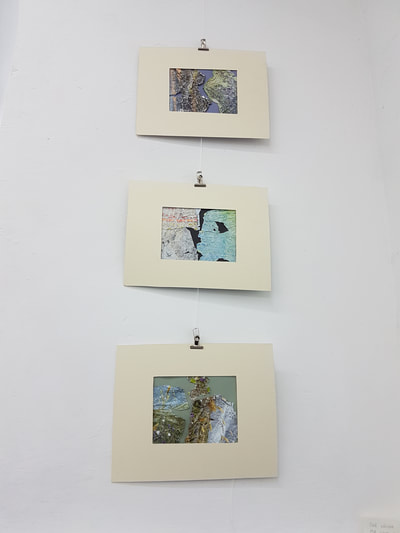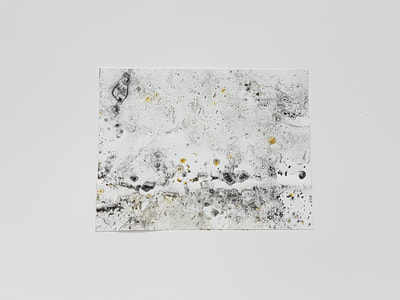|
Both my fellow MA students and collaborators on the Ireland trip have become inspiring and influential. The 'landscape' informs us all but we respond in completely different ways. This mix of responses makes for an extremely diverse but holistic partnership.
Sue Wright's approach is to 'map' the environment through the documentation of surrounding surfaces and detritus. One of her processes is to record 'surfaces' through physical on the spot printing using graphite powder, water and paper alongside the collection of discarded, mainly paper based, ephemera. Paula Hickey's approach is to embrace and harness the aesthetical 'feeling' of being within the environment. Using natural mark making; letting materials such as Indian ink respond naturally to application she intervenes little. Recognising the points at which to become involved in the process she visualizes the aesthetics, sensations and awareness of the embodiment of a particular landscape. With my own practice of the gathering of the 'physical' ephemera of an environment and my investigation and manipulation of this matter as a group we offer such great potential for further future collaborations and workshops and interventions.
0 Comments
Things are pretty full on at the moment. This week (in between working full-time) I am dedicating my time to the preparation of our (Myself, Paula & Sue) research/artists in residence trip to Ireland. I will be taking postcards of some of my work and framed skeletal leaf work to sell. I am limited to what I am able to take due to flying over but hope that these small pieces will generate a little income from my time there. Workshop and the presentation of how to present my practice will be worked on this week also. My strategy for the residency will be to harness the environment to enable mark making and to produce work that has very little intervention from traditional mark making materials.
This very much brings be back to my initial proposal for the MA. As a starting point the basic forms of mark making, prehistory, has underpinned the reasoning for my use of organic and ephemeral materials to make marks, in the broadest sense. 'As man enters the narrow opening of a limestone cave. Clutching a flickering tallow lamp and a small, precious object, he moves slowly into the dark depths. Soon he is aware of thick smoke and the overpowering odour of burning animal bone. He hears strange sounds echoing from the darkness. He knows that, in that smoke, people are scratching images of animals on small pieces of stone, and cutting across them with multiple lines' Lewis-Williams, David, The Mind in the Cave, 200 Being versatile and observant of unassuming materials presented within the landscape. Manipulating, scratching, scraping, pressing. To pick up an object; stone, wood, charcoal, soil, clay, plant life to make a physical mark is an instinctive action that prehistorical man had evolved enough to be able do. In writing this I remind myself that I have nowhere near touched on the questions I initially asked: What was the driving force behind these early forms of mark making and why did early man feel the desire to make a physical visual record of their lives? Maybe a subject for a PHD??? However, I have staid true to my practice and explored deeper the ways in which mark making can be formed through materiality intervention. It is this aspect that I will carry through into my time spent in Irish landscape. Delighted to say I have achieved International success! A skeletal leaf immersed in hand made paper piece has been accepted as part of the 2017 Annual International Mail- Art Exhibition in Canada. It is pretty mind blowing to think that a piece of my work will be situated as part of an exhibition so far away. The process undertaken to make these works consists of myself within the landscape here in the UK, Yorkshire. Materials are then brought into the studio space and manipulated to understand more their physical make-up and mark making potential. It is hoped that the work translates this physicality of materials and the environment in which it came. When situated in Canada it is my ambition that the work invites my audience to think twice about the overlooked and discarded ephemera of the land and how they themselves interact with the environment.
|
MA Creative Practice
|










 RSS Feed
RSS Feed
